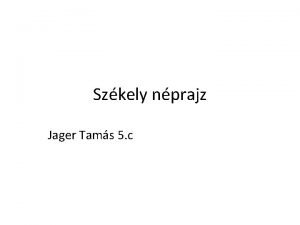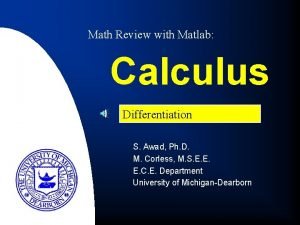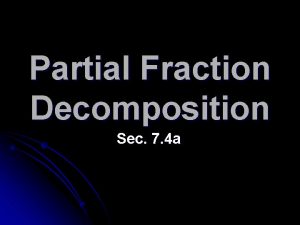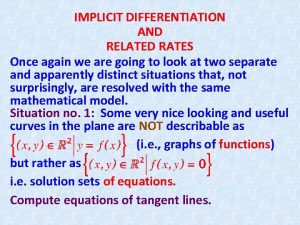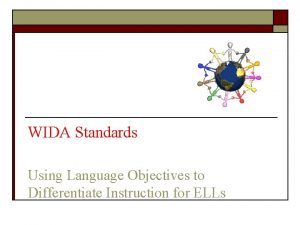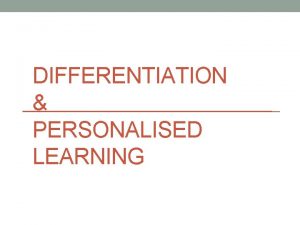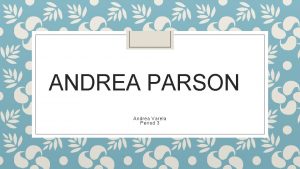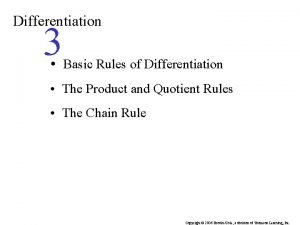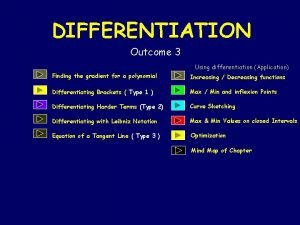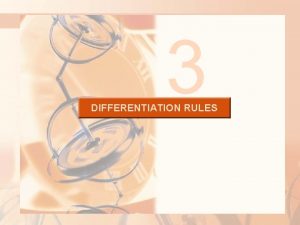Dr Andrea D Szkely Differentiation of the Neural























































- Slides: 55

Dr. Andrea D. Székely Differentiation of the Neural Tube Development of the Spinal Cord Neural Crest Derivatives Acknowledgements to Dr Márk Kozsurek Dr Nándor Nagy

Levels of Neural Differentiation • ORGAN macroscopical changes in the neural tube (hemispheres, ventricles) • TISSUE functional regions form in the wall of the neural tube (motor, sensory, autonomous) • CELLULAR Different neuronal and glial types differentiate (histogenesis)

Milestones in Neural Tissue Differentiation INDUCTION (chorda dorsalis ) - neuroectoderm NEURULATION formation of the neural tube PROGENITOR CELLS form in the neural tube PROLIFERATION and DIFFERENTIATION of the progenitors • Neurone • Glia MIGRATION, AXONAL GROWTH Formation of SYNAPSES (communication between distant cells)

Primary Neurulation Neural induction and neurulation Specification of neural fate and formation of the neural tube. NEURAL INDUCTION : the delineation of ectodermal cells to the neural fate NEURULATION: the process in which the ectoderm of the future brain and spinal cord - the neural plate – develops, folds and forms the neural tube

Primary Neurulation


Induction of the Neural Tube epiblast BMP-2 BMP-4 follistatin chordin noggin (BMPinhibition) N-Cadherin default pathway inhibition of activin default mesoderm inhibition of default epidermis E-cadherin neural tube Numerous signal proteins inhibit the activity of BMP/Activin, thereby maintaining the default mechanism ( neural tube )

Closure of the neural tube in a „zip-lock” like manner © 2005 Elsevier )

Secondary Neurulation (described in avian embryos) cavitation D 27 Below S 2 eminentia caudalis neural tube fusion

Development of the CNS Craniocaudal patterning

Developmental Overview Neural Tube Primary Vesicles Secondary Vesicles Adult Structures Telencephalon Rhinencephalon, Amygdala, Hippocampus, Cerebrum (Cortex), Basal Ganglia, lateral ventricles Diencephalon Epithalamus, Thalamus , Hypothalamus, Subthalamus, Pituitary, Pineal, third ventricle Mesencephalon Tectum, Cerebral peduncle, Pretectum, cerebral aqueduct Metencephalon Pons, Cerebellum Myelencephalon Medulla Oblongata Prosencephalon Brain Mesencephalon Rhombencephalon Spinal Cord

Development of the Brain, Neuromeres Differentiation of the rostral end isthmus Rhombomeres midbrain i M r 1 r 3 P 6 Key element: r 2 r 4 r 5 P 5 Hox Genes P 4 r 7 -8 P 3 P 2 T 21 r 6 P 1 Prosomeres

Spinal Cord Development Composition of Neural Tube Internal limiting membrane Neuroepithelial cells Sclerotomal somitic mesoderm External limiting membrane

Neuroepithelial Cells EXTERNAL LAYER Pia mater Neural tube INTERNAL LAYER Ependyma Simple cuboidal epithelium ALSO covering the choroid plexus Neuroblast (Apolar) Glioblast Astroblast Oligodendroblast Neuroblast (Bipolar) Neuroblast (Unipolar) Astrocyte (Protoplasmic) Astrocyte (Fibrous) Oligodendrocyte Neuron

Differentiation in the Wall of the Neural Tube The wall of a recently closed neural tube consists of neuroepithelial cells (pseudostratified epithelium) Once the neural tube closes, neuroepithelial cells begin to give rise to primitive nerve cells, or neuroblasts forming the mantle layer. The outermost layer of the spinal cord, the marginal layer, contains nerve fibers emerging from neuroblasts in the mantle layer

Differentiation in the Wall of the Neural Tube Formation of neurones and glia G 1 Synth G 2 Mitosis Happens in the vicinity of the lumen Nuclear migration Germinal neuroepithelium (pseudostratified simple epithelium expressing multiple divisions) layers (cortex), neuronal clusters (nuclei) connections LUMEN G 3 Vertical divisioning

Development of the Spinal Cord (cell body; grey matter) (axon rich; white matter)

Development of Spinal Cord Neurogenesis Neuroblasts have a central process extending to the lumen (transient dendrite), but when they migrate into the mantle layer, this process disappears, and neuroblasts are temporarily round apolar. With further differentiation, two new cytoplasmic processes appear on opposite sides of the cell body, forming a bipolar neuroblast (primitive axon, primitive dendrites) The cell is then a multipolar neuroblast and with further development becomes a neuron Neuroepithelial cells Bipolar neuroblast Multipolar neuroblast

Development of Spinal Cord Gliogenesis Glioblasts migrate from the neuroepithelial layer to the mantle and marginal layers In the mantle layer they differentiate into protoplasmic and fibrillar astrocytes In the marginal layer oligodendroglial cells differentiate. This cell forms myelin sheaths around the ascending and descending axons Later a third type of supporting cell, the microglial cell, appears in the CNS. This highly phagocytic cell type is derived from vascular mesenchyme when blood vessels grow into the nervous system

Migration along the Radial Glia in the CNS 40 μm/hour speed Glia vs neuron identification through astrotactin


Spinal Cord Development A. Marginal Zone 1. Derivative of neural tube 2. White matter portion of central nervous system B. Alar plate 1. Derivative of neural tube 2. Portion of central nervous system 3. Associated with afferent (sensory) function C. Basal plate 1. Derivative of neural tube 2. Portion of central nervous system 3. Associated with efferent (motor) function D. Sulcus limitans (between B and C) 1. Derivative of neural tube 2. Portion of central nervous system 3. Separates alar plate from basal plate Intermediate zone


Development of Spinal Cord Compartmentalisation and Organization roof alar plate dorsal horn (sensory interneurons) Central canal sulcus limitans lateral horn (autonomic nuclei) intermediate zone (grey substance) ventricular zone (ependyma) ventral horn (motor neurons) marginal zone (white substance) basal plate Pax-6 floor plate commissure

Above the Sulcus Limitans A. Dorsal Columns 1. Derivative of alar plate (neural tube) 2. Portion of central nervous system 3. Neurons in the dorsal columns constitute afferent nuclei B. Dorsal rootlet 1. Derivative of neural crest 2. Portion of peripheral nervous system 3. Composed of Schwann cells and cell processes for sensory neuroblasts in spinal (dorsal root) ganglion C. Afferent sensory neuroblasts in spinal (dorsal root) ganglion 1. Derivative of neural crest 2. Portion of peripheral nervous system 3. Associated with afferent (sensory) function

Below the Sulcus Limitans A. Ventral Columns 1. Derivative of basal plate (neural tube) 2. Portion of central nervous system 3. Neurons in the dorsal columns constitute efferent nuclei B. Lateral Columns 1. Derivative of basal plate (neural tube) 2. Portion of central nervous system 3. Neurons in the lateral columns constitute efferent nuclei C. Ventral roots of spinal nerve* 1. Derivative of neural tube 2. Portion of central nervous system 3. Cell processes for motor neuroblasts in ventral horn

Spinal Cord Development Afferent sensory Sulcus neuroblasts limitans Roof Plate Marginal Zone Afferent sensory Dorsal column Lateral column neuroblasts in spinal ganglion Dorsal root of spinal nerve Efferent motor neuroblasts Floor Plate Ventral column Ventral root of spinal nerve

Compartmentalization of the Spinal Cord

Development of Spinal Nerves Dorsal root ganglion Axons of the dorsal root multipolar Axons of the ventral root Motor nerve fibers begin to appear in the 4 th week, arising from cells in the basal plates. These fibers collect into bundles - ventral nerve roots Dorsal nerve roots form cells in dorsal root ganglia (spinal ganglia). Central processes form bundles that grow into the spinal cord opposite the dorsal horns. Distal processes join the ventral nerve roots to form a spinal nerve Almost immediately, spinal nerves divide into dorsal and ventral primary rami. Dorsal primary rami innervate dorsal axial musculature, vertebral joints, and the skin of the back. Ventral primary rami innervate the limbs and ventral body wall and form the major nerve plexuses (brachial and lumbosacral).

Development of Spinal Nerves Schwann cells myelinate the peripheral nerves with each cell myelinating only a single axon. These cells originate from neural crest, migrate peripherally, and wrap themselves around axons, forming the neurilemma sheath Beginning at the 4 th month of fetal life, many nerve fibers take on a whitish appearance as a result of deposition of myelin, which is formed by repeated coiling of the Schwann cell membrane around the axon. The myelin sheath surrounding nerve fibers in the spinal cord has a completely different origin, the oligodendroglial cells. Unlike Schwann cells, a single oligodendrocyte can myelinate up to 50 axons.

Nerve Fiber Coverings Schwann cell nucleus (PNS) Oligodendrocyte nucleus (CNS) Basement membrane Nerve fiber Unmyelinated axons Each Schwann cell is able to house multiple axons occupying invaginations of its cytoplasm. Myelinated axon Multiple wrapping of Schwann cell plasma membrane (“jelly - roll”) around single axon.

Myelination of Nerve Fibers • Myelin sheaths surrounding nerve processes in the CNS – – Begin to form during the late fetal period Continue during the first postnatal year. Formed by oligodendrocytes Derivative of neuroepithelial cells • Myelin sheaths surrounding nerve processes in the PNS – – – Begin about 20 weeks gestation Continue till puberty Formed by Schwann cells Derivative of neural crest Motor roots are myelinated before sensory roots

Positional Changes in the Spinal Cord 8 w 24 w newborn adult

Molecular Events Dorsal and ventral regions of the developing spinal cord are dependent upon concentration gradients between members of the transforming growth factor beta (TGF-b) family of growth factors secreted in the dorsal neural tube and sonic hedgehog (SHH) secreted by the notochord and floor plate. Initially BMP 4 and 7 are secreted by ectoderm overlying the neural tube, then, BMP 4 induces a cascade of TGF-b proteins, including BMP 5, BMP 7, activin, and dorsalin in the roof plate and surrounding area. As a result, cells near the roof plate are exposed to the highest concentrations with more ventrally positioned cells seeing less and less of these factors. Similar events occur in the ventral region of the neural tube, only the signaling molecule is SHH. This factor is first expressed in the notochord followed by the establishment of a second signaling center in the floor plate. As a result, there is a diminishing concentration of SHH from the ventral to the dorsal region of the neural tube. These gradients then activate transcription factors that regulate differentiation of sensory and motor neurons.

Derivatives of the Neural Crest Migration into the mesenchymal layer Craniocaudal streams EMT - Epithelial – to - mesenchymal transformation Influenced by: ECM molecules, growth factors

Regions of the Neural Crest • Cranial (caudal to the forebrain until the 6 th rhombomere) • Vagal (between somites 1 -7) • Truncal (somites 8 -28) • Lumbosacral (caudal to somite 29)

Neural and Non-neural Derivatives of the Cranial Neural Crest

Neural Derivatives of the Truncal Neural Crest pigment cells (melanocytes) dorsolateral pathway (1) neural crest dorsal root, cranial nerve sensory ganglia ventrolateral pathway (2) parasympathic and sympathic ganglia mesoderm developing adrenal gland

Neural Derivatives of the Truncal Neural Crest ventrolateral pathway neural crest Schwann’s cells satellite cells unipolar sensory neurons multipolar ganglion cells in sympathetic ganglions FGF, NGF chromaffine cells in adrenal glands glomus caroticum, parafollicular (C) cells prevertebral plexus

Sympathetic prevertebral ganglia T 1 -T 4 Superior & middle cervical & stellate ganglion Cardiac and lung plexus T 5 -L 2 Celiac ganglion Sup. mesenteric ggl. Aorticorenal ggl. Inf. mesenteric ggl. Preganglionic fibers Postganglionic fibers

Mesenchymal Derivatives of Cephalic and Cardiac Crest

Neural Derivatives of Truncal and Vagal Crest cells

DERIVATIVES OF THE NEURAL CREST 1 a bipolar neuroblast 1 b differentiating neuroblast 1 c pseudounipolar sensory neuron 2 a unipolar neuroblast 2 b vegetative ganglion cells (multipolar) 2 c adrenal medulla - chromaffin cells 3 a glioblast 3 b Schwann cells 3 c satellite cells 4 a mesenchymal cells 4 b leptomeningeal cells 4 c ectomesenchymal cells 5 pigment cell 5 b melanocyte

Thank you for your attention!

EMBRYOLOGY SUMMARY The spinal cord develops from the NEURAL PLATE from above the notocord. With the folding of the NEURAL TUBE the central canal is formed (lining: ependyme). Neuroepithelial cells will give rise to neurons and glia. (Head mesenchyme) the DRG and the sympathetic neurones derive from the neural crest. The proneurones form a mantle zone (grey matter) with the axons growing towards the surface and so is the marginal zone formed (turns later into white matter). The notochord secrets a factor known as Sonic hedgehog or SHH. As a result, the floor plate then also begins to secrete SHH, and this will induce the basal plate to develop motoneurons. Meanwhile, the overlying ectoderm secretes bone morphogenetic protein (BMP). This induces the roof plate to begin to secrete BMP, which will induce the alar plate to develop sensory neurons. The alar plate and the basal plate are separated by the sulcus limitans. Additionally, the floor plate also secretes netrins. The netrins act as chemoattractants to decussation of pain and temperature sensory neurons in the alar plate across the anterior white commissure, where they then ascend towards the thalamus. The marginal zone develops into a massive passage of axans divided into 3 funiculi by the grey matter, posterior, lateral and anterior.










DEVELOPMENTAL MALFORMATIONS
 Nagyegyed
Nagyegyed Székely himnusz eredete
Székely himnusz eredete Nguyên nhân của sự mỏi cơ sinh 8
Nguyên nhân của sự mỏi cơ sinh 8 Bổ thể
Bổ thể độ dài liên kết
độ dài liên kết Thiếu nhi thế giới liên hoan
Thiếu nhi thế giới liên hoan Fecboak
Fecboak Chúa yêu trần thế alleluia
Chúa yêu trần thế alleluia điện thế nghỉ
điện thế nghỉ Một số thể thơ truyền thống
Một số thể thơ truyền thống Sơ đồ cơ thể người
Sơ đồ cơ thể người Công thức tiính động năng
Công thức tiính động năng Các số nguyên tố
Các số nguyên tố Tỉ lệ cơ thể trẻ em
Tỉ lệ cơ thể trẻ em đặc điểm cơ thể của người tối cổ
đặc điểm cơ thể của người tối cổ Các châu lục và đại dương trên thế giới
Các châu lục và đại dương trên thế giới ưu thế lai là gì
ưu thế lai là gì Thẻ vin
Thẻ vin Môn thể thao bắt đầu bằng từ đua
Môn thể thao bắt đầu bằng từ đua Tư thế ngồi viết
Tư thế ngồi viết Bàn tay mà dây bẩn
Bàn tay mà dây bẩn Hình ảnh bộ gõ cơ thể búng tay
Hình ảnh bộ gõ cơ thể búng tay Từ ngữ thể hiện lòng nhân hậu
Từ ngữ thể hiện lòng nhân hậu Trời xanh đây là của chúng ta thể thơ
Trời xanh đây là của chúng ta thể thơ Tư thế ngồi viết
Tư thế ngồi viết Chó sói
Chó sói Ví dụ về giọng cùng tên
Ví dụ về giọng cùng tên Thơ thất ngôn tứ tuyệt đường luật
Thơ thất ngôn tứ tuyệt đường luật Hổ sinh sản vào mùa nào
Hổ sinh sản vào mùa nào đại từ thay thế
đại từ thay thế Thế nào là hệ số cao nhất
Thế nào là hệ số cao nhất Diễn thế sinh thái là
Diễn thế sinh thái là Vẽ hình chiếu vuông góc của vật thể sau
Vẽ hình chiếu vuông góc của vật thể sau Slidetodoc
Slidetodoc 101012 bằng
101012 bằng Thế nào là mạng điện lắp đặt kiểu nổi
Thế nào là mạng điện lắp đặt kiểu nổi Mật thư anh em như thể tay chân
Mật thư anh em như thể tay chân Lời thề hippocrates
Lời thề hippocrates Vẽ hình chiếu đứng bằng cạnh của vật thể
Vẽ hình chiếu đứng bằng cạnh của vật thể Chụp tư thế worms-breton
Chụp tư thế worms-breton Quá trình desamine hóa có thể tạo ra
Quá trình desamine hóa có thể tạo ra Sự nuôi và dạy con của hươu
Sự nuôi và dạy con của hươu Các châu lục và đại dương trên thế giới
Các châu lục và đại dương trên thế giới Dạng đột biến một nhiễm là
Dạng đột biến một nhiễm là The pitfalls of a differentiation strategy include
The pitfalls of a differentiation strategy include Integrity vs despair
Integrity vs despair Vector differentiation
Vector differentiation Differentiation in matlab
Differentiation in matlab Decompose into partial fractions
Decompose into partial fractions Supplementary design
Supplementary design Acute promyelocytic leukemia symptoms
Acute promyelocytic leukemia symptoms Differentiation vs specialization
Differentiation vs specialization Delayed differentiation and modular design
Delayed differentiation and modular design Implicit differentiation and related rates
Implicit differentiation and related rates Log and exponential derivatives
Log and exponential derivatives Wida language objectives examples
Wida language objectives examples

